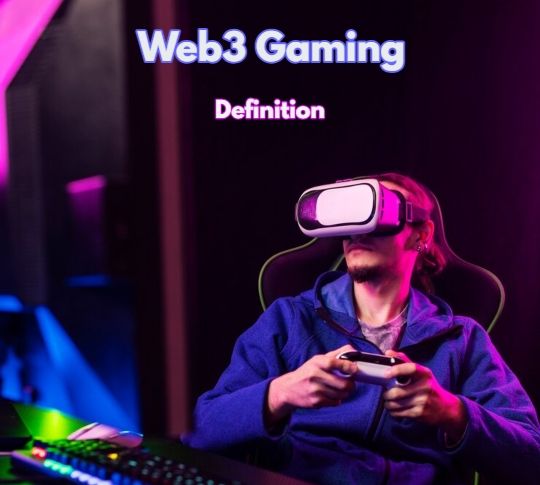Web3 gaming, definition and investment opportunities. Discover this ecosystem, which is growing every year, and the new opportunities it creates.
Web3 gaming represent a revolutionary evolution in the gaming industry, merging blockchain technology with interactive entertainment. Unlike traditional games, these experiences use decentralization and blockchain technologies to offer players unique experiences, where ownership of digital assets, such as non-fungible tokens (NFTs) or cryptocurrencies, is in the hands of the players. These games enable users to own, trade and monetize their virtual assets securely and transparently, transcending the boundaries of individual platforms to create an interconnected, scalable gaming ecosystem. »
What are Web3 games?
Web3 gaming, a term sometimes used to refer to GameFi and play-to-earn games, is linked to every digital game (Web3 dApps) that is based on blockchain technology. Each Web3 game ought to offer digital assets, such as NFTs or cryptocurrencies, enabling players to possess and trade these assets akin to physical goods. Crucially, these assets should be tradable not solely within a single platform or ecosystem (as seen in conventional games) but also across diverse chains and platforms.
Web3 gaming definition and application:
Web3 gaming, also known as decentralized gaming or blockchain gaming, represents a new generation of video games that take advantage of blockchain and decentralization technologies. Unlike traditional games, these experiences rely on decentralized networks, such as Ethereum, Tezos, Solana, and other blockchains, to offer unique features centered on the ownership, scarcity and interoperability of digital assets.
At the heart of Web3 games are NFTs (non-fungible tokens), unique and indivisible tokens registered on the blockchain, representing digital assets such as characters, objects, land, or other game elements. Each NFT has specific characteristics and immutable traceability, guaranteeing the authentic ownership and rarity of virtual assets.
These games allow players to truly own their digital assets, offering the possibility of trading, selling or using these assets both inside and outside the game. For example, a player can acquire an item in a game and resell it on an online marketplace for cryptocurrency, while retaining proof of ownership on the blockchain.
Interoperability is an essential aspect of Web3 games. Unlike traditional games, where assets are often confined to a specific platform, these games enable the exchange and use of assets across different games and networks, creating an interconnected ecosystem. For example, an NFT acquired in one game can be used or exchanged on another gaming platform compatible with the same blockchain standard.
The transparency and security offered by blockchain technology are fundamental elements of Web3 games. The immutable, decentralized nature of blockchain guarantees legitimate ownership of assets, eliminates the risk of tampering or duplication, and offers complete traceability of transactions.
In short, Web3 games are reinventing the way gamers interact with video games, offering a business model focused on digital asset ownership, scarcity, interoperability and security through the innovative use of blockchain technology. These games open up new opportunities for gamers, developers and creators, transforming the video game industry into a more open, transparent and participatory ecosystem.
Some major projects:
Some of these projects also represent attractive investment opportunities. Here are a few examples:
Axie Infinity: Axie Infinity is one of the most popular games on the Ethereum blockchain. It features creatures called Axies, which players can collect, breed, fight and trade. The game uses NFTs to represent each Axie, offering players the opportunity to own and trade their digital assets.
Decentraland: This is a decentralized virtual reality platform where users can buy, sell and own virtual land in the form of non-fungible tokens (NFTs). Land owners can create and monetize experiences, games and virtual real estate within this universe.
The Sandbox: Similar to Decentraland, The Sandbox is a blockchain-powered platform for the creation of virtual worlds. It enables users to design, share and monetize their game creations, assets and experiences using NFTs.
CryptoKitties: One of the first games to popularize the use of NFTs, CryptoKitties allows players to collect, breed and reproduce unique virtual cats, each represented by an NFT. Players can buy, sell and trade these NFTs on the market.
Splinterlands: Formerly known as Steem Monsters, Splinterlands is a blockchain-based trading card game where players own and trade NFT cards representing monsters. The cards are used to fight other players and earn cryptocurrency rewards.
These projects are among the most striking examples of Web3 games, each offering unique gaming experiences, exploiting NFTs and blockchain to enable the ownership, exchange and monetization of digital assets within their virtual worlds.
Projects to discover:
As the Web3 gaming ecosystem continues to grow and evolve, several projects stand out for their innovation, growing adoption and potential to shape the future of the industry. Here are a few promising projects to explore:
Immutable X (IMX): This is a scaling layer for games and decentralized applications (dApps) on Ethereum, aimed at solving the problems of congestion and high transaction costs. Immutable X offers a scaling solution for NFTs and games, enabling fast, low-cost transactions while preserving the security of the Ethereum blockchain.
Guild of Guardians: This multiplayer online role-playing game (MMORPG) combines competitive gameplay with NFT asset ownership. Players can acquire, collect and trade unique heroes (represented by NFTs) for use in epic battles.
Ethernity Chain: This platform aims to create NFTs authenticated by celebrities and renowned artists, offering unique and authentic digital works of art. Ethernity Chain focuses on the intersection between NFTs, philanthropy and collectibles.
Star Atlas: A strategy and space exploration game set in a blockchain universe, offering players the chance to own digital assets such as spaceships and land. It features an economic model based on DAO (decentralized autonomous organization) governance and resource economics.
Aavegotchi: A combination of DeFi (decentralized finance) and NFT-based games. Aavegotchis are tamagotchi-style characters that can be owned, traded and upgraded by players using Aave tokens.
Illuvium: A role-playing and strategy game where players capture, fight and collect digital creatures called Illuvials. Each Illuvial is a unique NFT, offering innovative game mechanics and evolutionary possibilities.
It’s important to note that the Web3 game ecosystem is constantly evolving, with new projects appearing regularly. Thorough research and understanding of the underlying mechanisms, community and business models are essential before embarking on exploration or investment in these projects.


Un commentaire sur « Web3 gaming, definition and investment opportunities »
Les commentaires sont fermés.